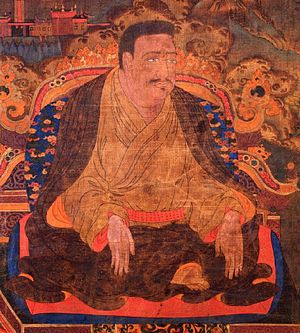Marpa Chokyi Lodro
Marpa Chokyi Lodro (mar pa chos kyi blo gros) (1012–1097), a.k.a. Marpa Lotsawa, was a Tibetan Buddhist teacher and translator "who played an important role in the later transmission (phyi dar) of Buddhism from India to Tibet.[1] He is regarded as the founder of the Kagyu school of Tibetan Buddhism, "which traces its lineage to India and the mahāsiddhas Tilopa and Nāropa."[1]
Marpa was born to wealthy landowners in the southern Tibetan region of Lho brag.[1]
Sam van Schaik states:
- As a child, Marpa Chokyi Lodro was such a troublemaker that his parents banned him from visiting the house of anybody except his teacher and a single friend. When he was fifteen Marpa's father decided to send him away to study Sanskrit with a famous translator, hoping that the experience might make a man of him. The translator was Drogmi, the famously expensive teacher who had also instructed Zur the Elder. While studying with Drogmi, Marpa noticed how much gold he was paid for giving the tantric empowerments and instructions that he had learned in India. As a result, he decided that what he really needed to do was to travel to India himself.
- And so Marpa, securing fifteen ounces of gold and some travelling boots and a hat from a wealthy patron, set out for India. Whereas Rinchen Zangpo and the other translators from Western Tibet tended to travel through Kashmir, Central Tibetans such as Marpa usually went via Nepal. The Kathmandu valley was itself a thriving centre for tantric Buddhism, and some Tibetans never went any further. Marpa spent three years there, partly to study and partly to adjust to the heat and humidity before travelling on to India.
- Though he met various eminent teachers in the Kathmandu valley, Marpa was keen to study with the famous master Naropa. Hence he travelled to Naropa's hermitage near the great monastic university of Nalanda in eastern India, and studied with the master there. When Marpa returned to Tibet, he increased his stores of gold by teaching. He offered the local nobles a ritual for protecting children, asking for ten ounces of gold for each performance. He was also fortunate to make friends with Goyak, a very rich man who was also from the Marpa clan. Goyak owned a gold mine that had recently been discovered, and was willing to pay Marpa handsomely for a tantric empowerment. Since Goyak encouraged other members of the clan to do the same, a large amount of gold came Marpa's way. Thus enriched, Marpa headed back to India for more teachings.
- [...]
- Back in India, Marpa travelled extensively and sat with many tantric masters, including some of the adepts known for their unorthodox behaviour, such as Kukkuripa, who lived like a dog. He also received more teachings from Naropa. When he finally returned to Tibet, Marpa was in his early forties, but before long he was off to India again for further teachings. Once, while travelling in Nepal, he was imprisoned by some corrupt border guards, an experience that led to a vision. While stewing in a hot prison cell with other Tibetans, hardly able to sleep at night, Marpa dreamed that two beautiful aristocratic Indian girls approached him with coy smiles. He followed them to the meditation retreat of Saraha, a great Indian adept of the teachings known as the Great Seal. In the vision Saraha gave Marpa direct instructions about meditation in the state of the Great Seal, urging him to be fearless like a lion, wander like an elephant and float like a bee. Marpa wrote down his dream in a poem based on an Indian song form known as the doha. He also translated dohas by Indian adepts such as Saraha. These songs spoke of the real nature of mind being ever present, and the futility of effort in meditation practice.[2]
Eventually Marpa returned to Tibet and settled down as a landowner in his native Lho brag. He married and fathered several children.[2] He attracted many students to whom he passed on the teachings he had gathered in India. His most famous disciple was the yogi Milarepa.
His four main disciples were: Milarepa, Ngog Chos sku rdo rje (Ngok Chöku Dorje), Mes tshon po (Me Tsönpo), ’Tshur dbang nge (Tsur Wangnge).[1]
At least sixteen of Marpa's translations from Sanskrit are included in the Tibetan canon.[1]
Notes
- ↑ 1.0 1.1 1.2 1.3 1.4 Buswell & Lopez 2014, s.v. mar pa chos kyi blo gros.
- ↑ 2.0 2.1 van Schaik 2011, pp. 113-115.
Sources
 Buswell, Robert E.; Lopez, Donald S. (2014), The Princeton Dictionary of Buddhism, Princeton University
Buswell, Robert E.; Lopez, Donald S. (2014), The Princeton Dictionary of Buddhism, Princeton University- van Schaik, Sam (2011), Tibet. A History, New Haven & London: Yale University Press
Further reading
 Marpa Chokyi Lodro, Treasury of Lives
Marpa Chokyi Lodro, Treasury of Lives
 Mar pa chos kyi blo gros, Tsadra Commons
Mar pa chos kyi blo gros, Tsadra Commons- Nalanda Translation Committee (1982), The Life of Marpa the Translator, Shambhala Publications
- Robert E. Buswell Jr., Donald S. Lopez Jr., The Princeton Dictionary of Buddhism (Princeton: 2014), s.v. mar pa chos kyi blo gros
- Marpa - His Life, Teachings and Images (archived 23/10/2005), Kagyu Asia
- Biography at kagyu office.org (archived)
- Biography at Karma Triyana Dharmachakra (archived)
